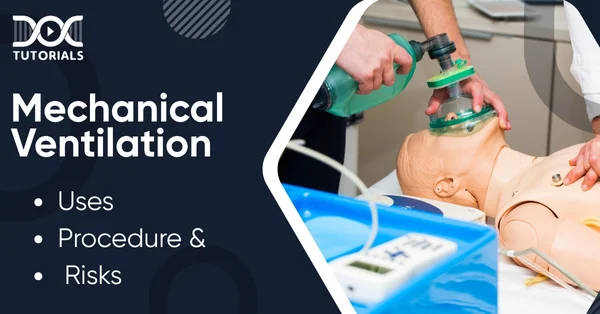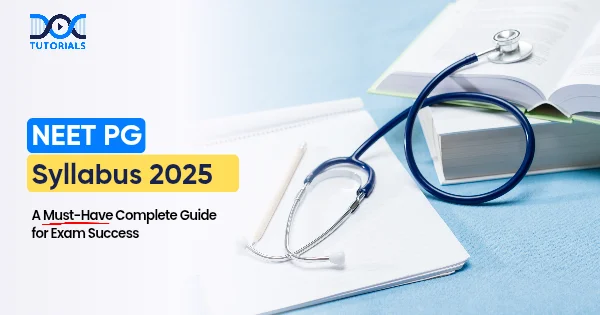Mechanical Ventilation | Uses, Procedure, and Risks

Mechanical ventilation is critical in managing acute or severe respiratory failure or emergencies. It is most needed when airways are blocked, respiratory muscles are relaxed, or oxygen is lacking. The use of a ventilator machine depends on airway resistance and lung compliance to deliver effective positive-pressure breaths.
If you’re a medical student preparing for the NEET PG exam, you must fully grasp the underlying mechanics of mechanical ventilation uses, side effects, and procedures, to guide clinical interventions and manage patients.
Keep reading for a detailed insight!
What is Mechanical Ventilation?
Mechanical ventilation is a medical process used to assist or substitute for spontaneous breathing if an individual is unable to breathe spontaneously.
The process usually occurs during surgery or in severe disease, resulting in compromised ventilation. Although it does not cure disease causation, mechanical ventilation is a bridge of support, providing the body with time to recover from drugs and other therapies.
What are the Different Types of Mechanical Ventilation?
Contemporary ventilators apply positive pressure to deliver air into the lungs. This method can be administered in 2 primary forms:
- Invasive Ventilation: A ventilator tube is placed inside the patient’s airway—into the mouth (endotracheal intubation) or through a surgically made airway opening in the neck (tracheostomy). The tube is connected directly to the ventilator.
- Noninvasive ventilation: Air is supplied through a tightly sealed mask on the nose or mouth. Standard devices include CPAP (Continuous Positive Airway Pressure) and BiPAP (Bilevel Positive Airway Pressure), which are often used in home care for conditions like sleep apnea or chronic respiratory disorders.
What are the Uses of Mechanical Ventilation?
Medical teams employ mechanical ventilator in hospital to aid patients who cannot maintain adequate oxygen levels or remove carbon dioxide efficiently. This form of respiratory support serves several critical purposes:
- Supplements oxygen to the lungs.
- Permits carbon dioxide removal, avoiding accumulation.
- Forces air into the airways to avoid lung collapse (atelectasis)
How to Place Someone on an Invasive Mechanical Ventilation?
When a patient needs invasive mechanical ventilation, the process generally involves a few essential steps performed by a skilled medical team:
- Sedation and Paralysis: Sedation is administered to keep the patient comfortable and relaxed, and paralytic medication is administered to limit movement during the procedure. While sedation will usually carry over into ventilation, the paralysis is reversible.
- Airway Insertion: Softly, an endotracheal (ET) tube is placed in the patient’s nose or mouth and inserted down the trachea to secure the airway.
- Ventilator Attachment: After the ET tube is correctly placed, it is connected to a ventilator machine, which assists or takes over breathing, depending on the patient’s status.
These guidelines can differ to some extent under emergencies or according to specific clinical requirements.
What Happens During Mechanical Ventilation?
During ventilation, patients are closely monitored and managed with several interventions to maintain stability and prevent complications, along with the following:
- Continuous Treatment: Ongoing treatment, such as medications and nutrition, is administered.
- Airway Clearance (Suctioning): A fine catheter is inserted through the ET (endotracheal) tube to remove mucus and maintain the airway’s patency. This procedure can cause occasional coughing or gagging.
- Medication Administration: Aerosol medication is administered directly into the lungs through the breathing tube, while other medication is administered intravenously.
- Nutritional Support: As oral intake is impossible, feeding is administered through a feeding tube passed from the nose to the stomach. IV fluids also offer hydration.
- Physical Activity: Depending on their status, patients are kept upright or mobilised as indicated to assist with recovery.
- Bronchoscopy: A tube can be passed down via the ET tube to look at the lungs and take specimens for laboratory testing.
What are the Benefits of Mechanical Ventilation?
Mechanical ventilation has several life-saving benefits, such as:
- Reduces the physical load of breathing to allow the body to concentrate on recuperation.
- Enables the transportation of oxygen and the elimination of carbon dioxide.
- Stabilises alveoli to prevent lung collapse.
- Aids in the maintenance and function of airways.
What are the Possible Risks of Mechanical Ventilation?
Despite its benefits, mechanical ventilation has certain risks. Medical teams take proactive steps to minimise them, but complications may still occur, such as:
- Ventilator-Associated Infections: Bacteria are passed into the lungs by the tube through which a patient breathes, creating potential infections such as pneumonia, which are then treated with antibiotics.
- Lung Injury: Bronchial settings at higher pressures can cause barotrauma or volutrauma of lung tissue.
- Pneumothorax: Soft portions of the lungs may cave in under pressure and lead to lung collapse.
- Cardiovascular Effects: Ventilation can influence heart rate and blood pressure, sometimes reducing blood pressure or heart rate.
- Prolonged Ventilation: Ventilator dependence can occur in certain patients. If prolonged support is anticipated, a tracheostomy should be performed.
- Problems at the End of Life: Mechanical ventilation might prolong dying instead of allowing recovery for critically ill patients. Physicians and families should carefully discuss the goals of care in such situations.
FAQs About Mechanical Ventilation
- What are the principles of safe mechanical ventilation?
The selection of an ideal mode of mechanical ventilation should be individualised to the patient. The goal is to maximise the ventilation-perfusion ratio and maintain an effective pressure-volume relationship. Comfort and synchrony with the ventilator are also factors in selecting the mode.
- What is the limit of mechanical ventilation?
Ventilators utilise a safety limit of the type Plimit. In the absence of such a facility, inspiratory pressure is limited to a high-pressure alarm level minus 10 cmH₂O to keep it in the safe zone.
- What are the complications of mechanical ventilation?
Barotrauma, ventilator-induced lung injury, and pneumonia are respiratory complications that can arise. Additional risks involve endotracheal tube-related issues, muscle weakness from disuse, and mucus retention in the airways.
- What is the normal range for mechanical ventilation?
In a clinical setting, a normal range is a range of results in 95% of normal patients. It is used to inform physicians when assessing ventilatory support and patient response.
- What is the setting of mechanical ventilation?
A standard sensitivity setting is –2 cm H₂O. If set too low (more negative), weak patients may struggle to trigger breaths. If too high (less harmful), the ventilator may auto-trigger, resulting in excessive ventilation.
Conclusion
Mechanical ventilation is an essential life-sustaining intervention when the individual cannot breathe independently because of serious illness or injury. It does not cure the disease or injury itself but allows healing through the provision of requisite support. In some cases of progressive or irreversible illness, patients may not regain the ability to breathe without assistance.
If you’re a NEET PG aspirant, it is important to understand mechanical ventilation to complete the syllabus and apply it to proper diagnosis and effective management in clinical practice.
DocTutorials will walk you through video lectures by experts, rapid revision programs (QRPs), and high-yield study notes—all specifically developed to support you through your exams and prepare you for success as a future medical practitioner.
Join our NEET PG courses today and enhance your medical preparation!
Latest Blogs
-

NEET SS Exam 2024: Analysis, Key Dates, Counselling
The NEET SS 2024 exam kicked off on March 29, 2025. Over two days and two slots, candidates across 13…
-

NEET PG Registration 2025: An Essential Guide For Exam Prep
The NEET PG registration, which is conducted online, is a crucial step in the exam process. Filling out the NEET…
-

NEET PG Syllabus 2025: A Must-Have Complete Guide for Exam Success
The NEET PG Syllabus acts as one of the foundation stones for aspiring postgraduate medical students like you who are…




